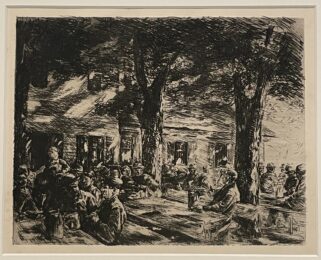


1847-1935
Max Liebermann was born in 1847 in Berlin, Germany and died in 1935 in the same city. He is considered by many one of the most important painters of German impressionism. His style was influenced by Monet and Degas.
He was born in a Jewish family of manufacturers and at the age of 16 he studies with Karl Steffeck. From 1868 to 1872, he studied painting and art history with Ferdinand Pauwels and later joined the landscape painter Theodor Hagen, through whom he met the Hungarian painter Mihály Munkácsy, whose work ‘Die Charpiezupferinnen’ (1871) made a lasting impressions on him.
His painting ‘Christ in the Temple’ (1879) provoked a scandal at the Third International Art Exhibition in Munich. Liebermann achieved his first great success with the paintings ‘Freistunde im Amsterdamer Waisenhaus’ (1881/82) and ‘Münchner Biergarten’ (1884) in the Paris Salon of 1884. In 1884, he moved to Berlin where along with Walter Leistikow, he founded the painter’s association XI.
In 1914 Liebermann moved back to his estate at Wannsee and in 1920 he became the president of the Prussian Academy of Arts. His honorary presidency ended in 1933 in protest against the appropriation of power by the National Socialists.